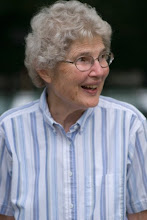 Guest Post by Vilo Elisabeth
Guest Post by Vilo ElisabethA friend of mine is taking a world religions class. Recently, they studied Judaism. “You have a Jewish connection, don't you?” she asked me. I explained that I'm a quarter Jewish, on my dad's side (which is enough to give me citizenship in Israel, but since it's from my father's side and not my mother's, doesn't count in some circles). “Do you make any Jewish food?” I had to think about this, and the answer made me laugh internally.
“Latkes, which are potato pancakes, out of a box. Matzo ball soup, out of a box. Oh, and challah—the braided bread.”
“Yeah, we had challah in class” she said, and that was the end of the discussion.
But I kept thinking about it afterward. I had laughed to myself because typically, I don't make much from a box or mix. Growing up, my mom might get a cake mix for a birthday cake, unless we wanted a spice cake or the special cinnamon cake my dad loves. But she made cookies and sometimes bread from scratch. I didn't even know you could buy a mix for cookies until I was 17. (I did know about pre-made cookie dough, but I also knew it wasn't that great. It was mostly just for sugar cookies, anyway.) We did use a Japanese curry mix to make a curry sauce to go with potatoes, carrots, and chicken, until my dad decided it was too unhealthy and created his own curry recipe using yogurt and spices.
I learned to make challah in my 8th grade home ec. class. When I brought the recipe home, my dad told me that his grandmother, Ann Goldberg, used to make challah. He remembered that from visiting her as a child. This is the first time I remembered him mentioning visiting his grandmother, or really anything about what she had been like or done. I kept the recipe, and started making the bread as a way to feel connected to her.
Throughout my childhood, the main connection to Jewish food was on our visits to Grandpa Art, who lived in LA. Although Grandpa Art was Agnostic, he took pride in being Jewish—the culture, the food, the intellectualism. He often commented on accomplished Jewish figures, and loved to remind me that no Mormons had ever won a Nobel prize, while many Jews had. (My response was that the Jews had been around a whole lot longer, and there are more of them.) During our visits, we frequented several Jewish Delis, such as Junior's and Fromins, or whatever place he was currently enamored with. We would order rye bread, bagel and lox, cheese blintzes with fruit.
On one of these visits, Grandpa Art gave us a menorah from Israel. After that we celebrated Hanukkah every year, and my dad would make latkes and serve them with sour cream and applesauce. He usually made them from a box, but would often grate potatoes and onions to add to the mix. At some point during my teenage years, we started celebrating Passover as well. We bought matzo, the flatbread that represents the quick bread that the Jews made before fleeing Egypt—made without leaven, since there was no time to let it rise. Matzo resembles gigantic bland saltines. We made the haroset, the mixture of finely minced apples, raisins and nuts that represents the mortar for the bricks that the Jews made as slaves, and shows the sweetness even during suffering. Celery was our bitter herb, and sometimes horseradish sauce, but I never wanted to eat much. I don't remember what we served for the main dish.
Then one year we went to my dad's cousin Juli's house for Passover. Juli is an amazing cook. She put together quite the spread. Besides the traditional components of the Seder plate, she had crudities and Greek olives for us to munch on during the Haggadah. Her Seder plate also included an orange, to show women's involvement in religion, and besides a glass of wine for Elijah, there was a glass of water to represent Miriam's well. (Juli and her son had a lively argument over if she was making too much of women's contributions to Passover. My father later remarked on this, saying that it was refreshing to see such a spirited debate without their being rancor or hurt feelings on either side.) Juli grew and ground her own horseradish, which made me a convert. We took some home and happily ate it for days. Juli and her family also introduced us to the multiple uses of matzo—to make french toast, for turkey sandwiches, covered in chocolate. Passover has been a much richer experience for me since.

Here's the soup I made for my seder this year. The matzo balls were from a mix, but the soup I made myself. Purple cabbage made the broth purple!

Matzo french toast has to be as traditional as PB & J on rotees. Beiji really looked bemused when she saw us eating that.
ReplyDeleteSheila
French toast? Do tell!
ReplyDeleteI had completely forgotten about Art saying that about Nobel prizes until you mentioned it. But yeah--he did say that a lot.
ReplyDeleteI think Henry's Eyring's dad won the Nobel Prize. Also another Mormon scientist quite recently. Anybody else?
Silus, it's pretty simple. You soak the matzo in egg/milk/cinnamon mixture like you use for french toast, and cook it in a frying pan. The matzo just takes the place of the bread.
ReplyDeleteIt's actually an old Ashkenazi recipe, so it's more traditional than PB&J rhotees.
ReplyDeleteThe traditional name is Matzah brei.
Henry Eyring actually never got the Nobel Prize-- he got several other awards, and some other chemists received it for building on his work, but it was one of those things where no one really understood how groundbreaking his research had been until later, and it never got to the Nobel committee. I don't know if any other Mormons have received it.